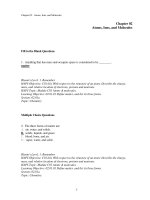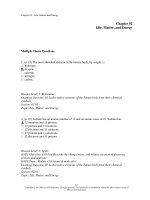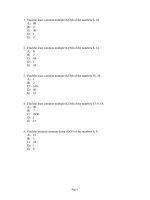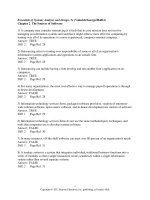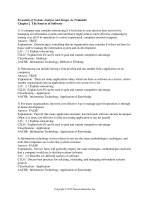Holes essentials of human anatomy and physiology 11th edition shier test bank
Bạn đang xem bản rút gọn của tài liệu. Xem và tải ngay bản đầy đủ của tài liệu tại đây (329.26 KB, 26 trang )
Chapter 02 Test Bank
Student: ___________________________________________________________________________
1. All of the food that we eat, liquids that we drink and medications that we take are
A. chemicals.
B. vitamins.
C. proteins.
D. nucleic acids.
E. carbohydrates.
2. Understanding ______________ is essential for understanding anatomy and physiology because
body structures and functions result from chemical changes.
________________________________________
3. Chemistry is the branch of science that deals with the composition of matter.
True
False
4. Which of the following substances is not an element?
A. Iron
B. Oxygen
C. Water
D. Carbon
E. Hydrogen
5. Matter is anything that has weight and takes up space.
True
False
6. ____________ is defined as anything that has weight and takes up space.
________________________________________
7. All matter is composed of atoms of fundamental substances called ________________.
________________________________________
8. All matter is composed of atoms of fundamental substances called ________________.
A. carbon, hydrogen, oxygen, nitrogen
B. carbon, hydrogen, oxygen, calcium
C. carbon, hydrogen, calcium, nitrogen
D. carbon, hydrogen, selenium, sodium
E. sodium, calcium, nitrogen, selenium
9. An element with an atomic number of 6 contains 12 protons.
True
False
10. At present, there are 90 known naturally occurring _______________.
________________________________________
11. Which of the following is the number of elements living organisms require?
A. 10
B. 15
C. 20
D. 90
E. 144
12. The atomic weight of an atom of an element equals the number of neutrons in its nucleus.
True
False
13. The atomic ___________ of an atom of an element equals the number of protons and neutrons in
its nucleus.
________________________________________
14. The number of protons in the atoms of a particular element is called the element's atomic
__________.
________________________________________
15. Each element is composed of characteristic tiny particles called _________________.
________________________________________
16. The parts of an atom that lack an electrical charge are called _________________.
________________________________________
17. When atoms combine with other atoms, interactions occur between their ______________shells.
________________________________________
18. The electrons of an atom occupy one or more areas of space called
A. bonds.
B. shells.
C. regions.
D. ions.
E. nuclei.
19. The electrons in the outermost shell of an atom determine its
A. shape.
B. weight.
C. chemical behavior.
D. mass.
E. atomic number.
20. The atoms of the isotopes of a particular element vary in the number of
A. electrons.
B. protons.
C. neutrons.
D. nuclei.
E. electron shells.
21. Sodium and chloride ions readily combine because they have opposite charges.
True
False
22. An atom that has gained or lost electrons is called an ion.
True
False
23. Atoms that gain or lose electrons become electrically charged and are called _____________.
________________________________________
24. The type of chemical bond formed when atoms share electrons is called _______________.
________________________________________
25. The first electron shell of an atom can hold a maximum of
A. 1 electron.
B. 2 electrons.
C. 4 electrons.
D. 8 electrons.
E. 16 electrons.
26. A covalent bond is formed by two atoms that share electrons.
True
False
27. The molecular formula for compounds like sodium chloride (NaCl) give the relative amounts of
each element present.
True
False
28. The formula H2O means
A. an atom contains 2 hydrogen molecules and 1 oxygen molecule.
B. an atom contains 1 hydrogen atom and 2 oxygen molecules.
C. a molecule contains 2 hydrogen atoms and 1 oxygen atom.
D. a molecule contains 1 hydrogen atom and 2 oxygen atoms.
E. a molecule contains 2 hydrogen atoms and no oxygen atoms.
29. If two pairs of electrons are shared, the resulting bond is called a double covalent bond.
True
False
30. The type of chemical bond formed when ions with opposite electrical charges are attracted to one
another is called _________________________.
________________________________________
31. The attraction of the positive hydrogen end of a polar molecule to the negative nitrogen or oxygen
end of another polar molecule is called a(an)
A. ionic bond.
B. double bond.
C. triple bond.
D. hydrogen bond.
E. covalent bond.
32. When two or more atoms bond, they form a new kind of particle called a molecule.
True
False
33. When atoms of different elements bond, they form molecules called _____________.
________________________________________
34. A molecule of a compound always contains definite kinds and numbers of atoms.
True
False
35. Water is an example of a compound.
True
False
36. A molecular formula represents the numbers and types of atoms in a molecule.
True
False
37. A _________ formula shows how atoms are joined and arranged in various molecules.
________________________________________
38. If the bonds of a reactant molecule break so that simpler molecules, atoms or ions form, the
reaction is an exchange reaction.
True
False
39. A _______________ reaction is symbolized as A+B→AB.
________________________________________
40. A ______________ reaction is symbolized as AB→A+B.
________________________________________
41. A chemical reaction in which pairs of two different molecules trade positions is called a(an)
_________ reaction.
A. decomposition
B. exchange
C. reversible
D. synthesis
E. irreversible
42. When two or more atoms (reactants) bond to form a more complex structure (product) the
reaction is called synthesis.
True
False
43. The opposite of a decomposition reaction is called a __________________ reaction.
________________________________________
44. A decomposition reaction can be symbolized as ________ .
A. A+B→C+D
B. A+B→AB
C. AB→A+B
D. C+D→AB
E. AB + CD → AC + BD
45. A pH value indicates the hydrogen ion concentration in solutions, including body fluids.
True
False
46. pH is a measure of _________ ion concentration.
________________________________________
47. The pH scale ranges from 0 to 14.
True
False
48. A pH of ___________ is the midpoint of the pH scale and signifies equal numbers of hydrogen
and hydroxide ions.
________________________________________
49. A solution that contains more hydrogen ions than hydroxide ions is _________.
________________________________________
50. Which term describes a solution that contains more hydroxide ions than hydrogen ions?
A. Basic
B. Neutral
C. Low pH
D. Acidic
E. None of the above
51. Each whole number on the pH scale represents a ____ - fold difference in hydrogen ion
concentration.
A. 15
B. 100
C. 20
D. 10
E. 2
52. As hydrogen ion concentration increases, the pH number
A. gets.
B. gets smaller.
C. stays the same.
D. becomes negative.
E. approaches 14.
53. A solution that has a pH of 6 has ten times the hydrogen ion concentration of a solution with a pH
of
A. 7.
B. 5.
C. 8.
D. 2.
E. 0.6.
54. A substance that releases hydrogen ions in water is a base.
True
False
55. An ______________ is defined as a substance that ionizes in water.
________________________________________
56. An acid is defined as an electrolyte that releases hydroxide ions (OH-) in water.
True
False
57. A person has alkalosis if the blood pH
A. rises above 7.0.
B. drops below 7.0.
C. rises above 7.4.
D. drops below 7.4.
E. steadily decreases.
58. As a group, compounds that release ions when they dissolve in water are called
A. acids.
B. bases.
C. salts.
D. electrolytes.
E. solvents.
59. Chemicals that resist changes in pH are called
A. buffers.
B. electrolytes.
C. acids.
D. bases.
E. none of the above.
60. Buffers combine with hydrogen ions when H+ is in excess or they donate hydroxide ions when H+
is depleted.
True
False
61. ____________ are chemicals that resist changes in pH.
________________________________________
62. A salt is a compound composed of oppositely charged ions.
True
False
63. At the cellular level of organization, biology becomes the study of
A. organs.
B. chemistry.
C. tissues.
D. organ systems.
E. human populations.
64. Which of the following chemicals is not an inorganic substance?
A. Water
B. Protein
C. Sodium chloride
D. Carbon dioxide
E. Oxygen
65. Many inorganic substances dissociate in water to release ions.
True
False
66. Organic substances always contain the elements hydrogen and _______________.
________________________________________
67. Inorganic substances that usually dissociate in water are called
A. organic compounds.
B. non-electrolytes.
C. electrolytes.
D. lipids.
E. carbohydrates.
68. Water accounts for 2/3 of the weight of an adult human.
True
False
69. ____________ is the most abundant compound in living material.
________________________________________
70. Carbon dioxide is
A. inhaled in large quantities from the environment.
B. a waste product of metabolic processes.
C. an element
D. a salt.
E. an electrolyte.
71. Cellular organelles use oxygen to release energy from glucose.
True
False
72. Which of the following is not organic?
A. A carbohydrate
B. A protein
C. A lipid
D. Carbon dioxide
E. A nucleic acid
73. The different types of carbohydrates do not include
A. monosaccharides.
B. disaccharides.
C. proteins.
D. polysaccharides.
E. glucose.
74. The building blocks of fat molecules are amino acids.
True
False
75. ______ are lipids used primarily to store energy for cellular activities.
________________________________________
76. Cholesterol is a protein.
True
False
77. Steroid molecules have four connected rings of carbon atoms.
True
False
78. The building blocks of proteins are amino acids.
True
False
79. __________________ are the building blocks of nucleic acids.
________________________________________
80. Proteins include DNA and RNA.
True
False
Chapter 02 Test Bank Key
1.
All of the food that we eat, liquids that we drink and medications that we take are
A. chemicals.
B. vitamins.
C. proteins.
D. nucleic acids.
E. carbohydrates.
Bloom's Level: 2. Understand
Learning Outcome: 02.01
Shier - Chapter 02 #1
Topic: Chemistry
2.
Understanding ______________ is essential for understanding anatomy and physiology
because body structures and functions result from chemical changes.
chemistry
Bloom's Level: 2. Understand
Learning Outcome: 02.01
Shier - Chapter 02 #2
Topic: Chemistry
3.
Chemistry is the branch of science that deals with the composition of matter.
TRUE
Bloom's Level: 1. Remember
Learning Outcome: 02.02
Shier - Chapter 02 #3
Topic: Chemistry
4.
Which of the following substances is not an element?
A. Iron
B. Oxygen
C. Water
D. Carbon
E. Hydrogen
Bloom's Level: 4. Analyze
Learning Outcome: 02.02
Shier - Chapter 02 #4
Topic: Chemistry
5.
Matter is anything that has weight and takes up space.
TRUE
Bloom's Level: 1. Remember
Learning Outcome: 02.02
Shier - Chapter 02 #5
Topic: Chemistry
6.
____________ is defined as anything that has weight and takes up space.
Matter
Bloom's Level: 1. Remember
Learning Outcome: 02.02
Shier - Chapter 02 #6
Topic: Chemistry
7.
All matter is composed of atoms of fundamental substances called ________________.
elements
Bloom's Level: 2. Understand
Learning Outcome: 02.02
Shier - Chapter 02 #7
Topic: Chemistry
8.
All matter is composed of atoms of fundamental substances called ________________.
A. carbon, hydrogen, oxygen, nitrogen
B. carbon, hydrogen, oxygen, calcium
C. carbon, hydrogen, calcium, nitrogen
D. carbon, hydrogen, selenium, sodium
E. sodium, calcium, nitrogen, selenium
Bloom's Level: 4. Analyze
Learning Outcome: 02.02
Shier - Chapter 02 #8
Topic: Chemistry
9.
An element with an atomic number of 6 contains 12 protons.
FALSE
Bloom's Level: 4. Analyze
Learning Outcome: 02.02
Shier - Chapter 02 #9
Topic: Chemistry
10.
At present, there are 90 known naturally occurring _______________.
elements
Bloom's Level: 1. Remember
Learning Outcome: 02.02
Shier - Chapter 02 #10
Topic: Chemistry
11.
Which of the following is the number of elements living organisms require?
A. 10
B. 15
C. 20
D. 90
E. 144
Bloom's Level: 1. Remember
Learning Outcome: 02.02
Shier - Chapter 02 #11
Topic: Chemistry
12.
The atomic weight of an atom of an element equals the number of neutrons in its nucleus.
FALSE
Bloom's Level: 1. Remember
Learning Outcome: 02.02
Shier - Chapter 02 #12
Topic: Chemistry
13.
The atomic ___________ of an atom of an element equals the number of protons and
neutrons in its nucleus.
weight
Bloom's Level: 1. Remember
Learning Outcome: 02.02
Shier - Chapter 02 #13
Topic: Chemistry
14.
The number of protons in the atoms of a particular element is called the element's atomic
__________.
number
Bloom's Level: 1. Remember
Learning Outcome: 02.02
Shier - Chapter 02 #14
Topic: Chemistry
15.
Each element is composed of characteristic tiny particles called _________________.
atoms
Bloom's Level: 1. Remember
Learning Outcome: 02.02
Shier - Chapter 02 #15
Topic: Chemistry
16.
The parts of an atom that lack an electrical charge are called _________________.
neutrons
Bloom's Level: 1. Remember
Learning Outcome: 02.02
Shier - Chapter 02 #16
Topic: Chemistry
17.
When atoms combine with other atoms, interactions occur between their
______________shells.
electron
Bloom's Level: 1. Remember
Learning Outcome: 02.02
Shier - Chapter 02 #17
Topic: Chemistry
18.
The electrons of an atom occupy one or more areas of space called
A. bonds.
B. shells.
C. regions.
D. ions.
E. nuclei.
Bloom's Level: 1. Remember
Learning Outcome: 02.02
Shier - Chapter 02 #18
Topic: Chemistry
19.
The electrons in the outermost shell of an atom determine its
A. shape.
B. weight.
C. chemical behavior.
D. mass.
E. atomic number.
Bloom's Level: 2. Understand
Learning Outcome: 02.02
Shier - Chapter 02 #19
Topic: Chemistry
20.
The atoms of the isotopes of a particular element vary in the number of
A. electrons.
B. protons.
C. neutrons.
D. nuclei.
E. electron shells.
Bloom's Level: 1. Remember
Learning Outcome: 02.02
Shier - Chapter 02 #20
Topic: Chemistry
21.
Sodium and chloride ions readily combine because they have opposite charges.
TRUE
Bloom's Level: 2. Understand
Learning Outcome: 02.02
Shier - Chapter 02
Topic: Chemistry
22.
An atom that has gained or lost electrons is called an ion.
TRUE
Bloom's Level: 1. Remember
Learning Outcome: 02.02
Shier - Chapter 02 #22
Topic: Chemistry
23.
Atoms that gain or lose electrons become electrically charged and are called _____________.
ions
Bloom's Level: 1. Remember
Learning Outcome: 02.02
Shier - Chapter 02 #23
Topic: Chemistry
24.
The type of chemical bond formed when atoms share electrons is called _______________.
covalent
Bloom's Level: 1. Remember
Learning Outcome: 02.02
Shier - Chapter 02 #24
Topic: Chemistry
25.
The first electron shell of an atom can hold a maximum of
A. 1 electron.
B. 2 electrons.
C. 4 electrons.
D. 8 electrons.
E. 16 electrons.
Bloom's Level: 1. Remember
Learning Outcome: 02.02
Shier - Chapter 02 #25
Topic: Chemistry
26.
A covalent bond is formed by two atoms that share electrons.
TRUE
Bloom's Level: 1. Remember
Learning Outcome: 02.02
Shier - Chapter 02 #26
Topic: Chemistry
27.
The molecular formula for compounds like sodium chloride (NaCl) give the relative amounts of
each element present.
TRUE
Bloom's Level: 2. Understand
Learning Outcome: 02.02
Shier - Chapter 02
Topic: Chemistry
28.
The formula H2O means
A. an atom contains 2 hydrogen molecules and 1 oxygen molecule.
B. an atom contains 1 hydrogen atom and 2 oxygen molecules.
C. a molecule contains 2 hydrogen atoms and 1 oxygen atom.
D. a molecule contains 1 hydrogen atom and 2 oxygen atoms.
E. a molecule contains 2 hydrogen atoms and no oxygen atoms.
Bloom's Level: 4. Analyze
Learning Outcome: 02.02
Shier - Chapter 02 #28
Topic: Chemistry
29.
If two pairs of electrons are shared, the resulting bond is called a double covalent bond.
TRUE
Bloom's Level: 2. Understand
Learning Outcome: 02.02
Shier - Chapter 02 #29
Topic: Chemistry
30.
The type of chemical bond formed when ions with opposite electrical charges are attracted to
one another is called _________________________.
ionic
Bloom's Level: 1. Remember
Learning Outcome: 02.02
Shier - Chapter 02 #30
Topic: Chemistry
31.
The attraction of the positive hydrogen end of a polar molecule to the negative nitrogen or
oxygen end of another polar molecule is called a(an)
A. ionic bond.
B. double bond.
C. triple bond.
D. hydrogen bond.
E. covalent bond.
Bloom's Level: 2. Understand
Learning Outcome: 02.02
Shier - Chapter 02 #31
Topic: Chemistry
32.
When two or more atoms bond, they form a new kind of particle called a molecule.
TRUE
Bloom's Level: 2. Understand
Learning Outcome: 02.02
Shier - Chapter 02 #32
Topic: Chemistry
33.
When atoms of different elements bond, they form molecules called _____________.
compounds
Bloom's Level: 2. Understand
Learning Outcome: 02.02
Shier - Chapter 02 #33
Topic: Chemistry
34.
A molecule of a compound always contains definite kinds and numbers of atoms.
TRUE
Bloom's Level: 2. Understand
Learning Outcome: 02.02
Shier - Chapter 02
Topic: Chemistry
35.
Water is an example of a compound.
TRUE
Bloom's Level: 2. Understand
Learning Outcome: 02.02
Shier - Chapter 02 #35
Topic: Chemistry
36.
A molecular formula represents the numbers and types of atoms in a molecule.
TRUE
Bloom's Level: 1. Remember
Learning Outcome: 02.02
Shier - Chapter 02 #36
Topic: Chemistry
37.
A _________ formula shows how atoms are joined and arranged in various molecules.
structural
Bloom's Level: 1. Remember
Learning Outcome: 02.02
Shier - Chapter 02 #37
Topic: Chemistry
38.
If the bonds of a reactant molecule break so that simpler molecules, atoms or ions form, the
reaction is an exchange reaction.
FALSE
Bloom's Level: 2. Understand
Learning Outcome: 02.02
Shier - Chapter 02 #38
Topic: Chemistry
39.
A _______________ reaction is symbolized as A+B→AB.
synthesis
Bloom's Level: 2. Understand
Learning Outcome: 02.02
Shier - Chapter 02 #39
Topic: Chemistry
40.
A ______________ reaction is symbolized as AB→A+B.
decomposition
Bloom's Level: 2. Understand
Learning Outcome: 02.02
Shier - Chapter 02 #40
Topic: Chemistry
41.
A chemical reaction in which pairs of two different molecules trade positions is called a(an)
_________ reaction.
A. decomposition
B. exchange
C. reversible
D. synthesis
E. irreversible
Bloom's Level: 2. Understand
Learning Outcome: 02.02
Shier - Chapter 02 #41
Topic: Chemistry
42.
When two or more atoms (reactants) bond to form a more complex structure (product) the
reaction is called synthesis.
TRUE
Bloom's Level: 2. Understand
Learning Outcome: 02.02
Shier - Chapter 02 #42
Topic: Chemistry
43.
The opposite of a decomposition reaction is called a __________________ reaction.
synthesis
Bloom's Level: 1. Remember
Learning Outcome: 02.02
Shier - Chapter 02 #43
Topic: Chemistry
44.
A decomposition reaction can be symbolized as ________ .
A. A+B→C+D
B. A+B→AB
C. AB→A+B
D. C+D→AB
E. AB + CD → AC + BD
Bloom's Level: 2. Understand
Learning Outcome: 02.02
Shier - Chapter 02 #44
Topic: Chemistry
45.
A pH value indicates the hydrogen ion concentration in solutions, including body fluids.
TRUE
Bloom's Level: 1. Remember
Learning Outcome: 02.02
Shier - Chapter 02 #45
Topic: Chemistry
46.
pH is a measure of _________ ion concentration.
hydrogen
Bloom's Level: 1. Remember
Learning Outcome: 02.02
Shier - Chapter 02 #46
Topic: Chemistry
47.
The pH scale ranges from 0 to 14.
TRUE
Bloom's Level: 1. Remember
Topic: Chemistry
48.
A pH of ___________ is the midpoint of the pH scale and signifies equal numbers of hydrogen
and hydroxide ions.
7 or
7
Bloom's Level: 1. Remember
Learning Outcome: 02.02
Shier - Chapter 02 #48
Topic: Chemistry
49.
A solution that contains more hydrogen ions than hydroxide ions is _________.
acidic
Bloom's Level: 2. Understand
Learning Outcome: 02.02
Shier - Chapter 02 #49
Topic: Chemistry
50.
Which term describes a solution that contains more hydroxide ions than hydrogen ions?
A. Basic
B. Neutral
C. Low pH
D. Acidic
E. None of the above
Bloom's Level: 4. Analyze
Learning Outcome: 02.02
Shier - Chapter 02 #50
Topic: Chemistry
51.
Each whole number on the pH scale represents a ____ - fold difference in hydrogen ion
concentration.
A. 15
B. 100
C. 20
D. 10
E. 2
Bloom's Level: 2. Understand
Learning Outcome: 02.02
Shier - Chapter 02 #51
Topic: Chemistry
52.
As hydrogen ion concentration increases, the pH number
A. gets.
B. gets smaller.
C. stays the same.
D. becomes negative.
E. approaches 14.
Bloom's Level: 2. Understand
Learning Outcome: 02.02
Shier - Chapter 02 #52
Topic: Chemistry
53.
A solution that has a pH of 6 has ten times the hydrogen ion concentration of a solution with a
pH of
A. 7.
B. 5.
C. 8.
D. 2.
E. 0.6.
Bloom's Level: 4. Analyze
Learning Outcome: 02.02
Shier - Chapter 02 #53
Topic: Chemistry
54.
A substance that releases hydrogen ions in water is a base.
FALSE
Bloom's Level: 1. Remember
Learning Outcome: 02.02
Shier - Chapter 02 #54
Topic: Chemistry
55.
An ______________ is defined as a substance that ionizes in water.
electrolyte
Bloom's Level: 1. Remember
Learning Outcome: 02.02
Shier - Chapter 02 #55
Topic: Chemistry
56.
An acid is defined as an electrolyte that releases hydroxide ions (OH-) in water.
FALSE
Bloom's Level: 1. Remember
Learning Outcome: 02.02
Shier - Chapter 02 #56
Topic: Chemistry
57.
A person has alkalosis if the blood pH
A. rises above 7.0.
B. drops below 7.0.
C. rises above 7.4.
D. drops below 7.4.
E. steadily decreases.
Bloom's Level: 3. Apply
Learning Outcome: 02.02
Shier - Chapter 02 #57
Topic: Chemistry
58.
As a group, compounds that release ions when they dissolve in water are called
A. acids.
B. bases.
C. salts.
D. electrolytes.
E. solvents.
Bloom's Level: 1. Remember
Learning Outcome: 02.02
Shier - Chapter 02 #58
Topic: Chemistry
59.
Chemicals that resist changes in pH are called
A. buffers.
B. electrolytes.
C. acids.
D. bases.
E. none of the above.
Bloom's Level: 1. Remember
Learning Outcome: 02.02
Shier - Chapter 02 #59
Topic: Chemistry
60.
Buffers combine with hydrogen ions when H+ is in excess or they donate hydroxide ions when
H+ is depleted.
FALSE
Bloom's Level: 2. Understand
Learning Outcome: 02.02
Shier - Chapter 02 #60
Topic: Chemistry
61.
____________ are chemicals that resist changes in pH.
Buffers
Bloom's Level: 2. Understand
Learning Outcome: 02.02
Shier - Chapter 02 #61
Topic: Chemistry
62.
A salt is a compound composed of oppositely charged ions.
TRUE
Bloom's Level: 1. Remember
Learning Outcome: 02.02
Shier - Chapter 02
Topic: Chemistry
63.
At the cellular level of organization, biology becomes the study of
A. organs.
B. chemistry.
C. tissues.
D. organ systems.
E. human populations.
Bloom's Level: 2. Understand
Learning Outcome: 02.03
Shier - Chapter 02 #63
Topic: Chemistry
64.
Which of the following chemicals is not an inorganic substance?
A. Water
B. Protein
C. Sodium chloride
D. Carbon dioxide
E. Oxygen
Bloom's Level: 4. Analyze
Learning Outcome: 02.03
Shier - Chapter 02 #64
Topic: Chemistry
65.
Many inorganic substances dissociate in water to release ions.
TRUE
Bloom's Level: 2. Understand
Learning Outcome: 02.03
Shier - Chapter 02 #65
Topic: Chemistry
66.
Organic substances always contain the elements hydrogen and _______________.
carbon
Bloom's Level: 1. Remember
Learning Outcome: 02.03
Shier - Chapter 02 #66
Topic: Chemistry
67.
Inorganic substances that usually dissociate in water are called
A. organic compounds.
B. non-electrolytes.
C. electrolytes.
D. lipids.
E. carbohydrates.
Bloom's Level: 1. Remember
Learning Outcome: 02.03
Shier - Chapter 02 #67
Topic: Chemistry
68.
Water accounts for 2/3 of the weight of an adult human.
TRUE
Bloom's Level: 1. Remember
Learning Outcome: 02.03
Shier - Chapter 02 #68
Topic: Chemistry
69.
____________ is the most abundant compound in living material.
Water
Bloom's Level: 1. Remember
Learning Outcome: 02.03
Shier - Chapter 02 #69
Topic: Chemistry
70.
Carbon dioxide is
A. inhaled in large quantities from the environment.
B. a waste product of metabolic processes.
C. an element
D. a salt.
E. an electrolyte.
Bloom's Level: 1. Remember
Learning Outcome: 02.03
Shier - Chapter 02 #70
Topic: Chemistry
71.
Cellular organelles use oxygen to release energy from glucose.
TRUE
Bloom's Level: 1. Remember
Learning Outcome: 02.03
Shier - Chapter 02 #71
Topic: Chemistry
72.
Which of the following is not organic?
A. A carbohydrate
B. A protein
C. A lipid
D. Carbon dioxide
E. A nucleic acid
Bloom's Level: 4. Analyze
Learning Outcome: 02.03
Shier - Chapter 02 #72
Topic: Chemistry
73.
The different types of carbohydrates do not include
A. monosaccharides.
B. disaccharides.
C. proteins.
D. polysaccharides.
E. glucose.
Bloom's Level: 4. Analyze
Learning Outcome: 02.03
Shier - Chapter 02 #73
Topic: Chemistry
74.
The building blocks of fat molecules are amino acids.
FALSE
Bloom's Level: 1. Remember
Learning Outcome: 02.03
Shier - Chapter 02 #74
Topic: Chemistry
75.
______ are lipids used primarily to store energy for cellular activities.
Fats
Bloom's Level: 1. Remember
Learning Outcome: 02.03
Shier - Chapter 02 #75
Topic: Chemistry
76.
Cholesterol is a protein.
FALSE
Bloom's Level: 1. Remember
Learning Outcome: 02.03
Shier - Chapter 02 #76
Topic: Chemistry
77.
Steroid molecules have four connected rings of carbon atoms.
TRUE
Bloom's Level: 1. Remember
Learning Outcome: 02.03
Shier - Chapter 02
Topic: Chemistry
78.
The building blocks of proteins are amino acids.
TRUE
Bloom's Level: 1. Remember
Learning Outcome: 02.03
Shier - Chapter 02 #78
Topic: Chemistry
79.
__________________ are the building blocks of nucleic acids.
Nucleotides
Bloom's Level: 1. Remember
Learning Outcome: 02.03
Shier - Chapter 02 #79
Topic: Chemistry
80.
Proteins include DNA and RNA.
FALSE
Bloom's Level: 2. Understand
Learning Outcome: 02.03
Shier - Chapter 02
Topic: Chemistry
